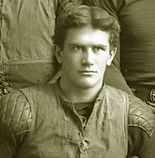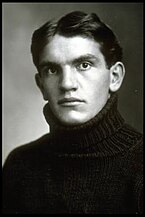History of Michigan Wolverines football in the Yost era
During the 28 years of the Yost era, Michigan claims six national championship (1901, 1902, 1903, 1904, 1918, and 1923), had two additional undefeated seasons (1910 and 1922), and compiled an overall record of 180–37–11 (.814).
[11] At the end of the 1901 season, Michigan traveled to Pasadena, California, to play against Stanford (the team that had fired Yost one year earlier) in the 1902 Rose Bowl.
The game was lost in the final ten minutes of play when Denny Clark was tackled for a safety as he attempted to return a punt from behind the goal line.
In 1932, he shot himself, leaving a suicide note that reportedly expressed hope that his "final play" would atone for his error at Marshall Field in 1905.
In November 1905, Stanford president David Starr Jordan wrote a feature article in Collier's magazine making allegations of "professionalism" at Michigan.
The gatherings, which became known as the Angell Conferences, condemned the "money end" of football and resolved that university faculty should have charge of gate receipts.
[29] In 1910, Michigan was led by All-Americans Albert Benbrook and Stanfield Wells and played its only undefeated season of the independent years, compiling a 3–0–3 record.
The 1918 Wolverines shared the Big Ten Conference championship with Illinois and finished with a perfect record of 5–0, outscoring opponents 96 to 6.
[40] Left end Bernard Kirk died of meningitis in December 1922 after sustaining a brain injury in an automobile crash.
[42] Yost retired as Michigan's head football coach before the start of the 1924 season in order to focus on his duties as the school's athletic director.
The only points allowed by the 1925 team were in a 3 to 2 loss to Northwestern, a game played in a heavy rainstorm on a field covered in mud five or six inches deep in some places.
The tradition of the Little Brown Jug began when Minnesota played Yost's 1903 "Point-a-Minute" team to a 6–6 tie—breaking Michigan's 28-game winning streak.
[55] The next day, custodian Oscar Munson brought the jug to L. J. Cooke, head of the Minnesota athletics department, and reportedly declared in a thick Scandinavian accent: "Yost left his yug."
Michigan's student manager, writing in 1956, stated that the jug had served its purpose, so he intentionally left it sitting on the field.
The Michigan Alumnus made note of the Aggies' potential as an athletic threat: "This victory with the football tie in 1908, and the Farmers' clean sweep in baseball in 1912, point to the fact that M.A.C.
"[60] In the celebration following the game, the Detroit Free Press reported that two Aggies fans were arrested and jailed for "throwing bottles about the streets" in the early hours of Sunday morning.
E. A. Batchelor, a sportswriter for the Detroit Free Press, submitted a report on the game with the headline: "'Shorty' Longman's Fighting Irishmen Humble the Wolverines to Tune of 11 to 3.
Michigan protested Notre Dame's use of two players (Philbrook and Dimmick) who had reportedly played more than four years of college football.
Animosity was also fueled by rumors that Ohio State officials had instigated a Big Ten investigation into the eligibility of Michigan halfback, Doug Roby.
[71][72] One newspaper reported on the exodus as follows:"Automobile parties will start from Ann Arbor on Friday and will form a steady parade between here and Columbus.
"[71]Michigan won, 19–0, in a game that The New York Times wrote had "crowned the greatest day in mid Western football history."
The rotunda at Ohio Stadium was painted with maize flowers on a blue background due to the outcome of the 1922 dedication game.
[68] Michigan's most significant rivalry during its independent years was with the Penn Quakers football team representing the University of Pennsylvania.
The Chicago Daily Tribune wrote that "Gaston slugged Garrels, knocking the big acting captain 'silly' for a few minutes and dazing him for the entire half.
The Times called Craig Michigan's "offensive and defensive hero" in a "clean, snappy, spectacular, thrilling" game.
In 1923, after seeing the University of Wisconsin football team carry live badgers at games, Coach Yost decided to procure a wolverine.
[105] An article in National Geographic magazine reported that "Yost had not accounted for the rapid growth or the ferocity of the animals, and when his players were no longer willing to carry the wolverines around the stadium, one live mascot, 'Biff,' was turned over to the University of Michigan Zoo so that the students would be able to visit—and be inspired by—him.
The current fight song, "The Victors", was composed by Michigan student Louis Elbel in 1898 following a last-minute football victory over the University of Chicago.
A new fight song called "Varsity", written by Michigan students Earl V. Moore and J. Fred Lawton, debuted in October 1911.
The announcers for the game were Ty Tyson and Leonard "Doc" Holland who were required to pay for tickets and set up their microphone in the stands of the east end zone.















